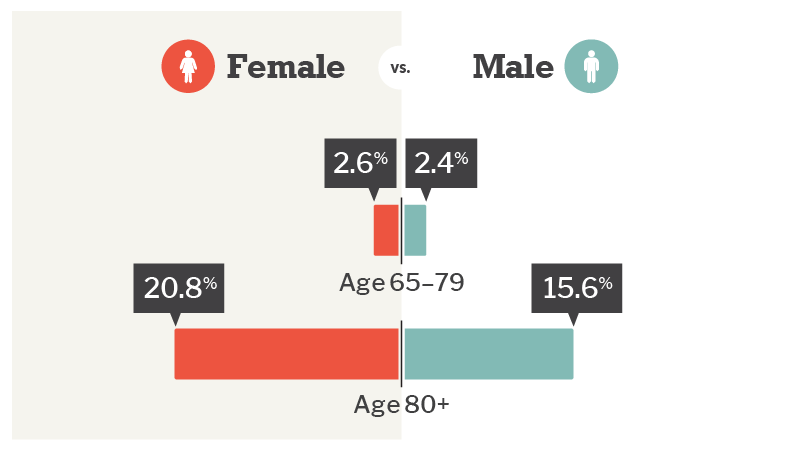How dementia impacts Canadians
Growing population of seniors driving up national numbers

The number of Canadian seniors living with Alzheimer’s disease and other forms of dementia is rising steadily, and so is the demand on their caregivers and health care systems across the country.
The Public Health Agency of Canada (PHAC), which collaborated closely with CIHI and provided key data to help prepare this report, estimates that more than 402,000 seniors, or 7.1% of all people 65 and older, were living with dementia in 2013–2014; two-thirds of those were women.Reference1 The case definition used to identify Canadian seniors with diagnosed dementia and the underlying methodology were selected to maximize the validity and national comparability of data.
The number of seniors living with dementia is more than 2.5 times the population of Prince Edward Island, and it increased 83% between 2002 and 2013. Over 20 years, it is estimated that the number of Canadians living with dementia would almost double due to the aging population and population growth.Reference2 Approximately 76,000 new cases of dementia are diagnosed in Canada every year — which is about 14.3 new cases per 1,000 people 65 and older.Reference1
There is no cure for Alzheimer’s disease — a disease that has a profound impact on those living with it, as well as their families and friends. … As our population ages, the number of Canadians with Alzheimer’s disease and other forms of dementia is expected to increase. … Together, we can discover ways to help people living with dementia as well as those who care for them. — Ginette Petitpas Taylor, Minister of HealthReference3
The Alzheimer Society of Canada and PHAC estimate that the total health care system costs and out-of-pocket costs of caring for people with dementia are 5.5 times greater than the costs for those without dementia.Reference4 By 2031, the National Population Health Study of Neurological Conditions projects that the total annual health care costs for Canadians with dementia will be double what it was 2 decades earlier, from $8.3 billion to $16.6 billion.Reference5
What is dementia?
Dementia refers to a set of symptoms and signs associated with a progressive deterioration of cognitive functions that affects daily activities. It is caused by various brain diseases and injuries. Alzheimer’s disease is a common cause of dementia, and vascular dementia, frontotemporal dementia and Lewy body dementia are other common types.Reference6 Among seniors, some studies indicate that mixed dementia is a common cause.Reference7
Symptoms of dementia interfere with activities of daily living and may include
- Memory loss
- Judgment and reasoning problems
- Changes in communication abilities
- Changes in mood and behaviour
- Altered visual perception
For example, people living with dementia may have problems keeping track of their belongings, become disoriented, forget to pay bills, have difficulties planning, have difficulties preparing meals, etc.
Who is affected?
Dementia rates are very low among those younger than 65 but increase dramatically with age. The prevalence of dementia more than doubles every 5 years among seniors (from less than 1% in those age 65 to 69 to about 25% in those age 85 and older). Dementia is as prevalent among those 80 and older as heart failure (a chronic condition that develops after the heart becomes damaged or weakened), and is more prevalent than stroke.Reference1
People in every region of the country are impacted by dementia, though there is provincial and territorial variation in the prevalence of the diagnosed disorder. While the data captures differences in population health status, geographical variations may also reflect differences in drug database coverage and access to dementia drugs across jurisdictions, as well as other differences in data collection methods, coding and classification systems, or clinical and billing practices.
Dementia’s impact in Canada
Trends in age-standardized dementia incidence and prevalence, by sex
The age-standardized prevalence of dementia grew steadily from 2002 to 2013: from 5.7% to 7.3% for women and from 4.7% to 6.1% for men. Age-standardized incidence remained steady at 1.5% for women and 1.4% for men. Prevalence is the proportion of people in a population who have a disease at a specified point in time. Incidence is the occurrence of new cases of a disease in a population over a specified period of time.
Dementia prevalence by sex in Canada, 2013–2014
Dementia affects women more than men and the gap increases with age. The prevalence of dementia among seniors age 65–79 is 2.6% for women and 2.4% for men. From age 80, prevalence for women is higher at 20.8%, compared with 15.6% for men.
Dementia prevalence by age in Canada, 2013–2014
Dementia rates are very low for those younger than 65, but the rate increases with age. Prevalence doubles approximately every 5 years from 0.8% for seniors age 65–69, to 2.4% for seniors age 70–74, to 5.9% for seniors age 75–79, to 12.4% for seniors age 80–84, and to 24.6% for seniors 85+.
Prevalence of dementia versus heart failure, 2013–2014
Dementia rates increase with age. The prevalence of dementia for seniors age 65–79 is 2.5% and the prevalence of heart failure is 5.9%. Dementia is as prevalent as heart failure among seniors age 80+, at 18.8% and 18.9%, respectively.
Age-standardized prevalence of dementia for seniors 65+ in Canada, 2013–2014
The age-standardized prevalence rate of dementia in Canada is 6.8%. There is provincial and territorial variation in the prevalence of dementia: N.L., 3.4%; P.E.I., 6.7%; N.S., 6.2%; N.B., 5.6%; Que., 7.2%; Ont., 7.3%; Man., 6.2%; Sask., not available; Alta., 7%; B.C., 6.3%; territories, 4.2%. Geographic variation reflects differences in population health status and may also reflect differences in data availability and collection methods.
References
- 1.
- Return to reference 1 in text
- Public Health Agency of Canada. Dementia in Canada, including Alzheimer’s disease External link, opens in new window. Accessed February 13, 2018.
- 2.
- Return to reference 2 in text
- Public Health Agency of Canada. Chapter 3: Scope (prevalence and incidence) of neurological conditions External link, opens in new window. Mapping Connections: An Understanding of Neurological Conditions in Canada. 2014.
- 3.
- Return to reference 3 in text
- Public Health Agency of Canada. Ministerial message World Alzheimer’s Day, September 21, 2017 External link, opens in new window. Accessed February 13, 2018.
- 4.
- Return to reference 4 in text
- Alzheimer Society of Canada. Prevalence and Monetary Costs of Dementia in Canada: Population Health Expert Panel (PDF) External link, opens in new window. 2016.
- 5.
- Return to reference 5 in text
- Public Health Agency of Canada. Mapping Connections: An Understanding of Neurological Conditions in Canada (PDF) External link, opens in new window. 2014.
- 6.
- Return to reference 6 in text
- Alzheimer’s Association. What is dementia? External link, opens in new window. Accessed February 13, 2018.
- 7.
- Return to reference 7 in text
- Boyle PA, et al. Person-specific contribution of neuropathologies to cognitive loss in old age External link, opens in new window. Annals of Neurology. 2017.
How to cite:
Canadian Institute for Health Information. How dementia impacts Canadians. Accessed April 25, 2025.
If you would like CIHI information in a different format, visit our Accessibility page.







